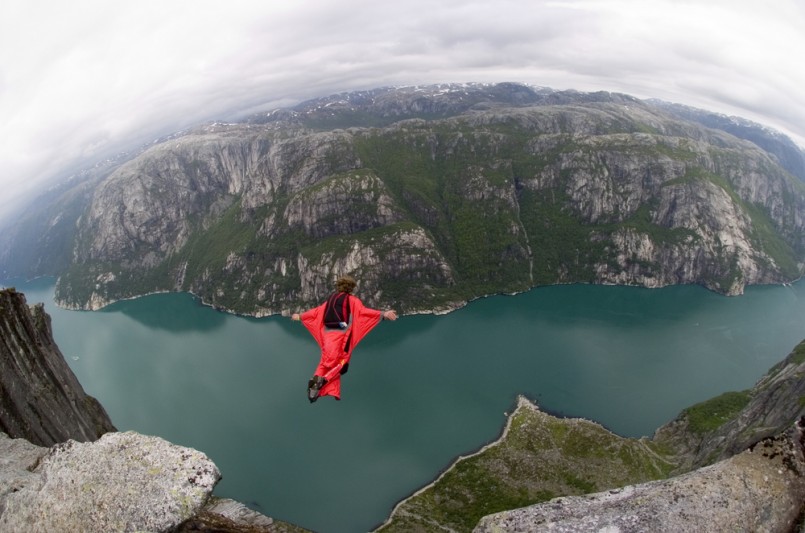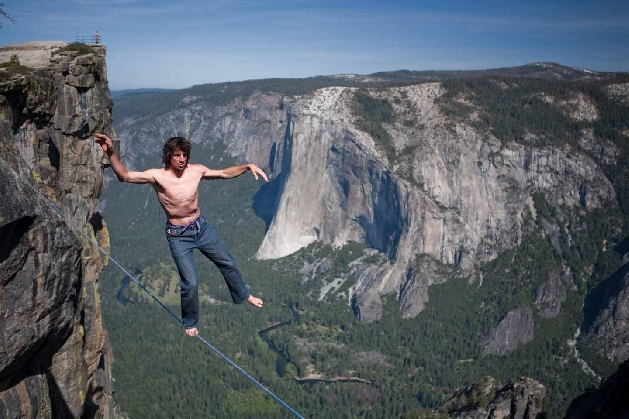Outdoors
This Is Why BASE Jumping Should Never Be Illegal

Image: Shutterstock/Christophe Michot
This Is Why BASE Jumping Should Never Be Illegal
BASE jumping should never be illegal because it is a sport that maximizes safety. This sounds absurd to anyone who has ever heard just one story of an athlete who died from the activity. But BASE jumping saves lives. When a climber decides to free solo El Capitan in Yosemite, it would be illegal to wear a BASE jumping pack on his or her back. If the climber slips and falls off the wall and releases a wingsuit, that climber will be put in jail for six months. But at least the climber is alive. If the climber decides to follow the law and leave the wingsuit behind, then a single slip means falling to his or her death.
So when I say BASE jumping saves lives, I mean it allows climbers to free solo with the chance of saving their own lives should they make a single mistake. BASE jumping gives climbers the freedom to test the limits of and improve their sport. If BASE jumping is illegal, then climbing might as well be banned too. And if climbing is illegal, then shouldn’t every extreme sport be banned? Where would we draw the line on extreme sports if BASE jumping is completely forbidden? Every day there’s someone on a mountain bike flipping in the air and landing safely on rocks and dirt, and there’s someone skiing down the most extreme mountain faces in the world. It’s just what some people do. To deny them extreme sports is to deny them the freedom to pursue their dreams.
BASE jumping is completely illegal in Australia. Those within its borders who wish to BASE jump must travel to do so. But in order to BASE jump safely, athletes who professionally BASE jump need places to practice on a regular basis. Safe BASE jumping requires consistent practice, just like any sport of talent requires practice, practice, and more practice. So Australian BASE jumpers sneak around and try to jump in areas where they won’t be caught. The regulations aren’t effective and have only made BASE jumping more dangerous in Australia because athletes are going to extreme measures to get their practice time in. Policymakers think banning BASE jumping is common sense, but outlawing BASE jumping simply increases the chance of injury or death for Australian BASE jumpers.
BASE jumpers, climbers and extreme sports athletes are heroes to many young people. In an effort to become their heroes and eventually become even better than them, new BASE jumpers will seek out experienced jumpers for guidance. Unfortunately they are turned away because experienced jumpers don’t want to risk breaking the law. This leaves new and hopeful BASE jumpers to fend for themselves, jumping before they’re ready and in places that aren’t safe.
BASE jumpers, both new and experienced, will jump later in the evening in hopes of evading authorities. This decreases visibility, increasing their chances of death. But these athletes would rather risk death than land and face a park ranger who can arrest, tase and fine them thousands of dollars, or land them in jail. The banning of the sport has indirectly caused too many BASE jumper deaths.

Image: Shutterstock/Atmosphere1
The safest cliffs for BASE jumping are located in national parks. Unfortunately, BASE jumping is illegal in all of the U.S. national parks. It is illegal in almost every American city. Perrine Bridge in Twin Falls, Idaho and the New River Gorge’s Bridge Day are the only legal outlets for BASE jumping in the United States. But in order to qualify for these jumps you have to have already jumped at least one hundred times, jumped within the past two years, and have completed a training course. These requirements are nearly impossible if you are obeying the law.
Not all BASE jumpers are reckless thrill junkies intending to put their lives at risk. They’re not all single twenty-something’s with catchy bios and polished Instagram accounts. Many work in corporate offices and have children and spouses. The world can judge them all they want for putting their lives at risk, potentially leaving their families behind, but most extreme athletes are well aware of the risks they take and have respectable reasons for doing so.
Banning BASE jumping is a waste of resources because people will continue to do the sport anyways. Policymakers and athletes should be working together to maximize safety. BASE jumping can make many extreme sports much safer, and the more athletes practice jumping, the safer the sport will become. Sports like white water rafting, skiing, hiking, bungee jumping, and much more come with safety rules and regulations and have publicly-funded emergency services. These sports often result in the same amount of deaths per year as BASE jumping. With the right boundaries, regulations, and emergency services, BASE jumping can be a sport that people can choose to participate in knowing that it’s as safe as it possibly can be while understanding the risk that is still involved. Instead of helping a BASE jumper heal from a severe injury in secrecy, athletes could call for an ambulance without being sent to jail after.
Many people have this fabricated idea that search and rescue teams are constantly tending to injured and near-death BASE jumpers and that this is the reason why the bans were created. In Yosemite alone, 3,467 people required search and rescue assistance in 2014. The majority of these people were day hikers. Of these people, 164 died, 39 were hikers, 20 swimmers, and 19 boaters. Only three were BASE jumpers. Search and rescue was called 16 times to rescue pets. Horses in Yosemite kick people in the heads, throw their riders off steep trails, and they tear up the grounds in the park, but no one is saying they’re an “unnecessary risk,” as BASE jumping is so often described.

Image: Mount Live
Dean Potter, who died last year in a BASE jumping accident in Yosemite, said, “I love the idea that I can change the worst possible thing to the best possible thing—dying to flying. Life and death is right there for all of us. It’s the most common thing we all share.”
Why argue about which risky and potentially fatal activities we should ban? The people so concerned with banning BASE jumping are not likely to ever BASE jump in their lifetimes. Instead, let’s focus on the ways in which we can choose to live and make the most of the lives we have been given.





3 Comments